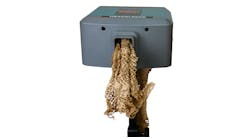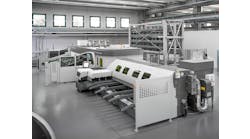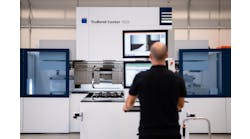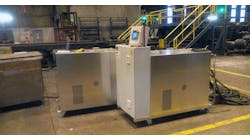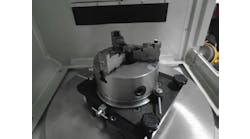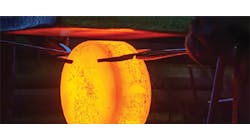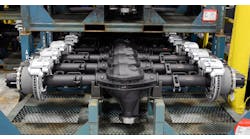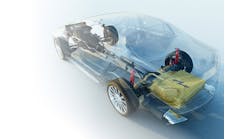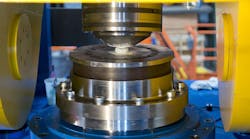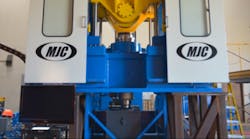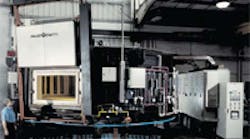An idea, or technology, doesn’t have to be revolutionary to be effective. Frequently, a new approach to an established technology will reveal new opportunities for development.
In a recent case, rotary forging technology has gained a new horizon of possibilities thanks to a process expert, an interested manufacturer, a willing research center, and a machine builder with different technical proficiencies have combined to produce a rotary forging machine with the potential to produce critical parts in difficult-to-form aerospace alloys, and with high dimensional precision.
If the development process continues in this way, it’s possible that rotary forging could be an alternative to precision machining, saving production time and material costs.
The new rotary forging press was built by MJC Engineering & Technology Inc., of Huntingdon Beach, CA. It’s not a source familiar to forgers, because MJC’s expertise is custom design and building of metal forming machinery, such as spinning, flow forming, and wheel spinning.
Standard rotary forging technologies have been used for at least a century. Research published by Prof. Peter M. Standring of the University of Nottingham, in England, recounted various designs and commercial applications. The basic idea involves two rotating dies driven by spindles, with the lower die in a horizontal plane and the top die set at a fixed angle. Between the two rotating dies, a workpiece is shaped in a continuous manner, to a final design.
As a forging process, it uses low levels of force because it relies on a reduced instantaneous area of tool and workpiece contact. Typical products are round or cylindrical hollow parts. But, as Standring wrote, the finished products have been limited in variety, and that made rotary forging vulnerable to alternative processes, such as machining or casting.
MJC president Carl Lorentzen recalled that one of his company’s customers made an introduction for him at Rolls-Royce Plc: the aircraft engine builder was interested in proving out some flow-forming technologies for its own design efforts, and felt that MJC should propose a design for such a machine.
That machine would be installed at the Advanced Forming Research Centre (AFRC), a non-profit program at the University of Strathclyde in Glasgow, Scotland.
Rolls-Royce is one of the equity partners in AFRC (others include Aubert & Duval, Barnes Aerospace, Boeing, and Timet), and it felt that would be a fitting place to install and test its flow-forming concepts.
Concurrently, Rolls was interested in testing some new rotary forging ideas. In this, Rolls was prompted in part by the expertise of Standring. MJC managed to bid for both equipment contracts, and while it lost on the technology for which it is known it landed the assignment to build the new rotary forging machine.
Insights and Encouragement
The offer was tendered in January 2011, and while he acknowledged his inexperience in the process at that time, Lorentzen credited Standring for guiding his own firm’s development of the new machine, and for encouraging AFRC to proceed with a new approach to rotary forging.
Over the next two years, the machine was designed not with fixed-angle dies but with two synchronized rotary dies. In this version, the angle of the dies is fully programmable from 0 to 45 degrees. The machine will be installed and operating at AFRC in January 2014.
As Standring wrote more than a decade ago, “incremental deformation” is the core of the rotary forging process, but machine, tooling, and process design features have limited the potential. Now, principally through the availability of modeling data, advanced motors and drives, and CNC controls, rotary forging can produce parts with complex geometry and even near-net-shape components.
The design of the MJC machine allows the metal to be compressed in a concentrated area, thus making metal deformation more efficient while producing better mechanical properties in the finished section. Its round and cylindrical products will have a greater range of shape and detail, and greater dimensional precision, and that means it’s available to form high-value materials into complex geometries.
According to Carl Lorentzen, “We can form flanges, external or internal flanges, we can form things that are not possible on a normal rotary forging machine. Being able to control the motion on the top spindle, both vertically, up and down, and from 0 to 45 degrees gives this machine some features that are nowhere to be found today.”
The control of the dies is driven by Siemens AC vector motors and drives, and overall motion control is supplied by Siemens’ Sinumerik 840D CNC. That package controls all axis and spindle motions, hydro and servo positioning valves, and synchronizes up to four cylinders for the integrated motion of the rotary dies. In the processing of the workpiece, the CNC control monitors every machine condition and maintains the synchronized angles of the twin rotary dies.
Programmed motion sequences on the machine must be maintained with high precision to avoid improper deformation of the materials. In a manufacturing environment, where the high production output of parts is critical, this process must remain well-regulated, documented, and monitored, and the CNC is able to manage all that critical data in real time.
“Though the concept of the rotary die forge is certainly not new, the computer-controlled, synchronized dual rotary dies on this machine offer a number of unique advantages in the cold-forming process of metals,” Lorentzen explained.
He compared this application to a similar process in the automotive supply chain.
Beyond Practical Implications
“The idea originated in a somewhat different form in the automotive market with the development of a front wheel hub hollow shaft. Cold forming of metal around a bearing was combined with robot loading in production. The concept, combined with the Siemens CNC and its ability to control all the motion so precisely, made the development of this machine more practical for us.”
The MJC rotary forging process compresses high-hardness metals in a concentrated area between two rotating dies, making metal deformation more efficient while producing better mechanical properties in the finished section.
“Practical” would be a modest evaluation of the implications for aerospace suppliers like Rolls-Royce, who may expect to achieve material savings of up to 90% using rotary forging in place of conventional machining from solid blanks. Considering the cost of materials in aerospace applications—at AFRC, the MJC rotary forging machine will process AerMet 100, Inconel 718 and Allvac 718Plus, Ti-6Al-4V and Ti6242, and some beta alloys, too—the financial savings could be considerable. The reduced process time would provide a similar advantage.
AFRC is a research center—not a manufacturer. But the demonstration of this new approach to forging will have implications for many producers of critical parts, some of whom may be induced to take a new look at this old technology.
